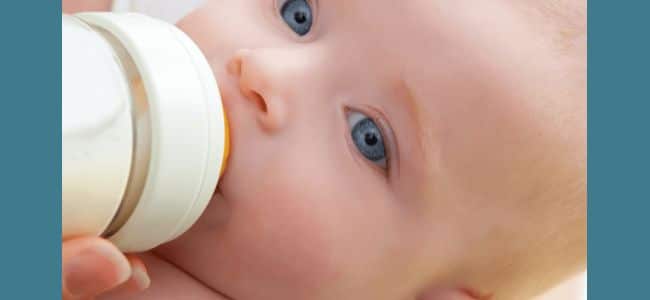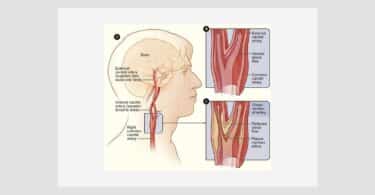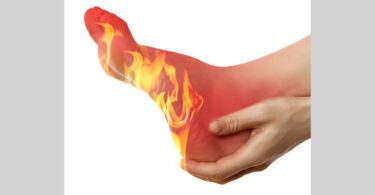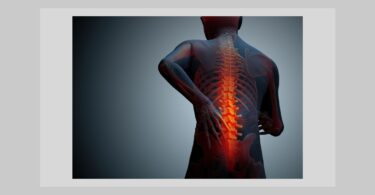Summary
Cow milk protein allergy (CMPA) is an often-missed clinical condition in primary health cares services though it has a reasonable prevalence amongst infants. A 5 months old infant with suspected CMPA was brought for homoeopathic consultation after introduction of formula milk and allopathic medicines failed to improve her condition. The baby’s symptomatology presented a clinically identified triad of symptoms that indicated the potentised homoeopathic remedy DPT, which was prescribed in ascending LM potencies with full recovery of the child´s health.
Keywords
Cow milk protein allergy, CMPA, homoeopathy, potentised DPT
Introduction
Cow’s milk protein is the leading cause of allergy in infants and children younger than three years.(1) Cow’s milk protein allergy (CMPA) (Homeopathy Treatment for Milk Allergy) affects nearly 2-7.5% of children in Europe.(2) True CMPA does seem to peak in the first year of life, with a prevalence of approximately 2% to 3% in the infant population, which then falls to <1% in children of 6 years and older.(1) CMPA is easily missed in primary care settings and needs to be considered as a cause of infant distress and diverse clinical symptoms in both exclusively and partially breast-fed infants. Early diagnosis and adequate treatment decrease the risk of impaired growth and development.
CMPA is an immunological reaction to one or more milk proteins: α-lactalbumin, ß-lactoglobulin, casein, IgE or non-IgE associated with immediate or late onset symptoms which distinguishes it from other adverse reactions such as lactose intolerance.(2,4)
The most frequent symptoms of CMPA are listed in the table below:
| Region | Signs and symptoms |
| GIT tract | Frequent regurgitation |
| Vomiting | |
| Diarrhoea or Constipation (with/ without perianal rash) | |
| Blood in stool (Melena and Hematoschezia) | |
| Skin | Atopic dermatitis |
| Angio-oedema | |
| Urticaria | |
| Respiratory tract | Rhinitis
Otitis media Recurrent cough with or without wheeze |
| General | Persistent distress or colic (wailing/irritable for ⩾3 h per day) at least 3 days/week over a period of >3 weeks |
| Serology | Iron deficiency anemia
Increased S. IgE levels Etc. |
Cow’s milk allergy should be suspected in children who have immediate symptoms such as acute urticaria/ angioedema, wheezing, rhinitis, dry cough, vomiting, laryngeal edema, acute asthma with severe respiratory distress and anaphylaxis. Late reactions due to cow’s milk allergy are atopic dermatitis, chronic diarrhoea, blood in the stools, iron deficiency anaemia, gastroesophageal reflux disease, constipation, chronic vomiting, colic, poor growth (food refusal), enterocolitis syndrome, protein-losing enteropathy with hypoalbuminemia and eosinophilic oesophago-gastroenteropathy.(3)
The suspicion of CMPA is based on detailed family and medical history, skin test, patch test, laboratory test, an elimination diet and food challenge. The general treatment for CMPA is dietary: elimination of cow’s milk protein and introduction of extensively hydrolyzed whey or casein formula, amino acid formula and soy formula. (2)
While the diagnosis and treatment of CMPA is still a challenge for modern medicine (5), the homoeopathic system, with its patho-biographical approach is able to provide positive results, as our experience in the following case shows.
Case study
Baby A.K., 5 months old was brought by her parents on 09/07/2016 for homoeopathic consultation for clinically suspected CMPA with recurrent flatulent colic, episodic frank hematoschezia and melena. On observation she was a wheatish complexioned, chubby girl with black eyes, hair and thin lips. She was apparently fine at birth. At about one and a half months of age, she started crying excessively. The crying worsened after 6 pm and she would be better being carried around, rather than being left in a cot. All through the episode of worsening, she would be weepy but not cranky. When the various colic aid mixtures prescribed by her treating physicians failed to provide any relief, she underwent routine stool examination (March 2016), which showed the presence of pus cells, occult blood and RBCs. The treating doctors suspected CMPA and advised the parents to introduce formula milks instead. A few courses of antibiotics and probiotics thereafter failed to ameliorate her complaints but her stool examination reports (repeated every month since March 2016) remained unchanged.
At the time of the first homoeopathic consultation it was reported by parents that in spite of introduction of various formula feeds and top feeds (apple, banana, lentil soup etc.), her colic, crying and discomfort continued. She also passed much wind (at times smelly) and also burped throughout the day.
The stool examination report dated 28/06/2016 revealed pus cells, occult blood as well as a few RBCs (given below).
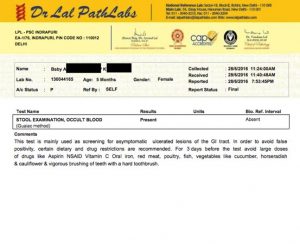 |
 |
She was passing greenish yellow and black coloured stool mixed with mucous with a strong/ foul odor, 2-3 times daily (see image below).
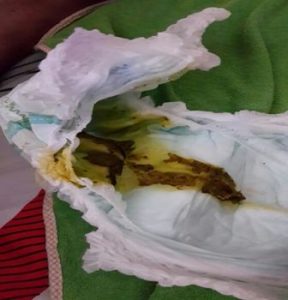 |
| 09/07/2016 |
Her appetite was good, in spite of the entire trouble and she continued to be active and gain weight. Her milestones were also on time.
Intra-uterine history
It was an unplanned pregnancy. Mother worked throughout the pregnancy and suffered with some UTI in the 1st trimester for which she was treated with some IV antibiotics. She also faced some nausea during the 1st trimester.
Her mother had a craving for Indian Chinese fast food preparations (containing lots of red chillies, vinegar and monosodium glutamate) all through pregnancy and during the 8-9 months (near term) had an equally strong craving for McDonalds burgers. Also during the 8th month, the mother was diagnosed with gestational diabetes. She delivered the baby by LSCS due to non-dilatation of cervix in spite of injectable medicines.
Her birth weight was 3.75 kgs and APGAR scorings were 9 & 9.
Past illnesses and development
She developed mild physiological jaundice after birth which she recovered from at home.
Vaccination history
Given all vaccines till date (details not available)
Family history
Mother- allergic rhino-sinusitis
Maternal uncle- Tuberculosis
Maternal GM- Osteoarthritis, Hypertension
Maternal GF- Diabetes Mellitus
Father- Food allergies to prawns, milk and shellfish
Paternal GF- Bells palsy
Paternal GM- Osteoarthritis
Generals
Perspiration: neck and axilla
T/R: prefers air conditioner and fan both together
Mind and disposition
She is generally cheerful and mild
Even during the evening flare-ups, she is weepy and wants to be carried, which soothes her, but she is not cranky
Analysis
The totality of symptoms could be summed up thus:
The child was passing greenish stool (like Chamomilla), was better by carrying (like Chamomilla) but mild (like Pulsatilla).
In our humble experience, this triad of symptoms indicates the potentised homoeopathic remedy prepared from DPT vaccine.
Prescription and follow up
| Date | Status | Prescription |
| 09/07/16 | Weight: 8.3 kgs | DTP LM1, 100 ml to be given once daily |
| 30/07/16 | Much better; no more colic; she started having very comfortable evenings the very next day onwards.
Weight: 8.3 kgs Her stool examination report has been normal (report dated 27/07/16 given below) Parents carried the vaccination chart: 1st DTaP vaccine was given on 12/03/16, followed by irritability and fever 2nd DTaP vaccine was given on 15/04/16. |
DTP LM2, 100 ml to be taken once daily |
| 20/08/16 | Normal stool color
Weight: 8.5 kgs Her stool examination report has been normal (report dated 17/08/16 given below) |
DTP LM3, 100 ml, once daily |
| 10/09/16 | Normal stool color
She has been introduced on regular cow milk Weight: 8.5 kgs |
DTP LM4, 100 ml |
| 01/10/16 | She developed 3 boils on left lower arm in previous 4-5 days; there was no fever; otherwise she has been doing very well and no adverse reaction has been observed after introduction of cow milk.
Weight 8.7 kgs |
DTP LM0, 100 ml (Placebo) |
| 05/11/16 | The boils healed soon and she has been doing very well with regular cow milk intake for nearly two months now.
Weight 8.7 kgs Parents were informed that no further follow-ups are required, unless the complaints returned. |
The child was prescribed DTP LM0, 100 ml (Placebo), and the parents were asked to administer it only if any complaints were observed. |
Post treatment investigations
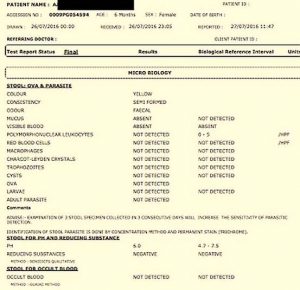 |
|
 |
|
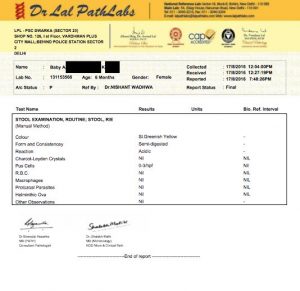 |
|
Discussion and conclusion
During our training as students and assistants under various teachers and masters of homoeopathy, the most important thing to learn was to note every symptom (and its modality) carefully, precisely in the language of the patient.(6) A similar strategy was to be followed while doing the follow up of each and every patient after the suitable remedy had been prescribed. This can help us not only to revise the symptomatology carefully but also identify (and after due verification) contribute some clinical symptoms.
Some of the medicines (like DPT) are purely used on the basis of causation, wherein the possibility can be established with greatest likelihood. In the above-mentioned case, we could verify the possible triggering effect of the DTaP vaccine only retrospectively (during the 1st follow up) as the vaccination chart wasn’t available during initial consultation.
Over the years wherever potentised DPT was prescribed on this basis (causation), the triad of clinical symptomatology was observed and recorded by us: The child passes greenish stool (like Chamomilla), is better by carrying (like Chamomilla) but mild (like Pulsatilla). And the remedy was prescribed to the child during the first consultation based on this recorded observation.
Further, during the follow up on 10/09/16, her parents informed that since her complaints had improved and stool examination reports were normal after homoeopathic medicines, the grand parents of the child had insisted re-introduction of cow milk to the child, which fortunately did not produce any complaints.
During the next follow up (01/10/16), in the absence of any complaints (and appearance of the boils), the child was prescribed placebo in accordance with the guidelines of Hahnemann’s Organon in aphorism 246 (6th edition): “Every perceptibly progressive and strikingly increasing amelioration during treatment is a condition which, as long as it lasts, completely precludes every repetition of the administration of any medicine whatsoever, because all the good the medicine taken continues to effect is now hastening towards its completion…”(7)
The drug has never been proved properly, however some clinical materia medica of DPT has been compiled by Warkentin and Marlow and can be accessed online.(8,9)
References
- Koletzko S at al. Diagnostic Approach and Management of Cow’s-Milk protein Allergy in Infants and Children- ESPGHAN GI Committee Practical Guidelines. JPGN 2012 Aug; Vol 55 No 2:221-229
- Solinas C et al. Cow’s Milk Protein Allergy. J Matern Fetal Neonatal Med 2010 Oct;23 Suppl 3:76-9
- Caffarelli C et al. Cow’s Milk Protein Allergy in Children: A Practical Guide. Ital J Pediatr 2010; 36:5.
- Homoeopathy for everyone. Hpathy.com [Internet]. Hpathy Ezine, July 2012, accessed online on 05/11/16 at https://hpathy.com/cause-symptoms-treatment/milk-allergy/
- Vandenplas Y, Greef ED, Devreker T. Treatment of Cow’s Milk Protein Allergy. Peditr Gastroenterol Hepatol Nutr 2014 Mar; 17(1): 1–5.
- Hahnemann, S. Organon of Medicine 6th edition-§ 84. B Jain Publishers (P) Ltd, India. Reprint edition 2004; 121
- Hahnemann, S. Organon of Medicine 6th edition-§ 246. B Jain Publishers (P) Ltd, India. Reprint edition 2004; 214
- Warkentin DK. An Image of DPT The Diphtheria Pertussis Tetanus. Homeopathy World Community. Creating Waves of Awareness 2010 Sept: Accessed online on 07/11/16 at
- Marlow L, Diamantopoulo K and Razzell L. DPT and Autism. Homeopathytoday 2010: Accessed online on 07/11/16 at https://homeopathyonline.org.uk/8-2/dpt/

